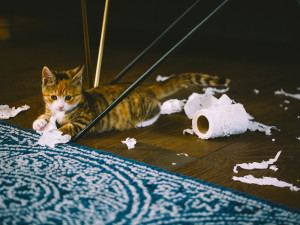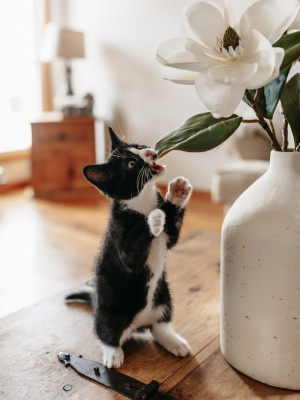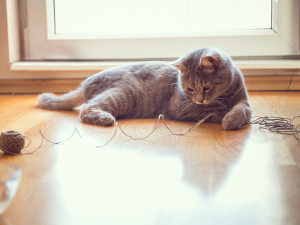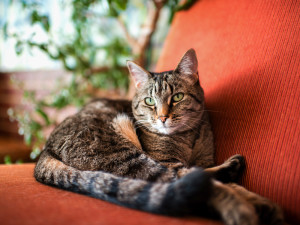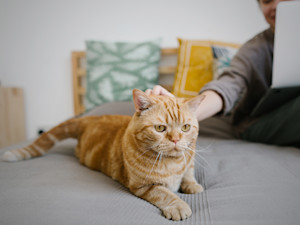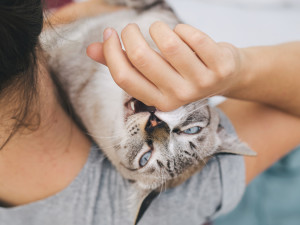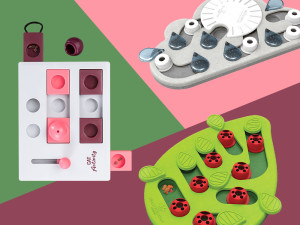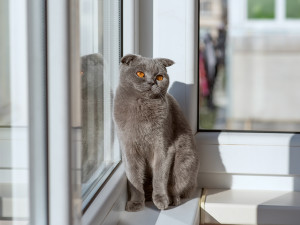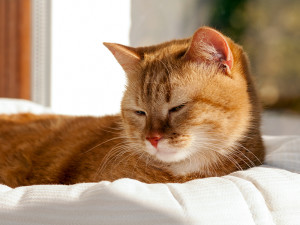How to to Spot, Treat, and Prevent Pica in Your Cat
There may be a reason your cat can’t stop putting your hair ties in their mouth.
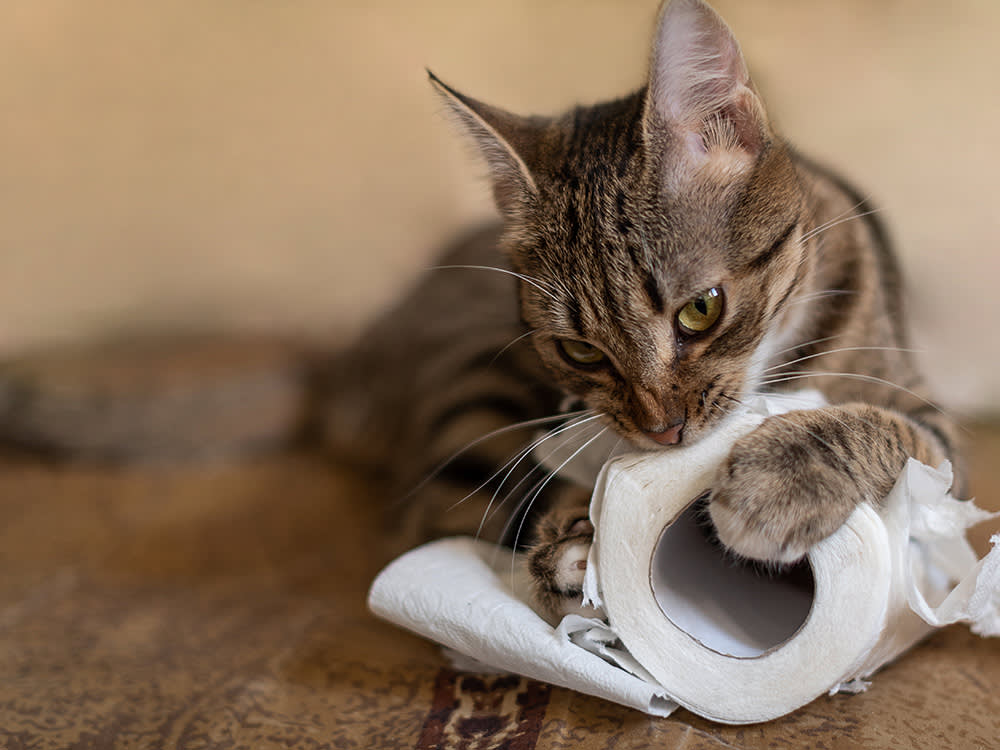
Share Article
Cats are lovable weirdos who always surprise us with their unpredictable antics: sleeping in the smallest boxes they can find, drinking from the faucet, or chewing on random things around the house. And while most of these antics are harmless, some cats take the chewing of inedible objects to the point of pathology. Cats who chew and swallow non-food items may have a condition called pica. It is a nuisance for pet parents who have to work overtime to try to cat-proof their homes, and it can also be a serious problem for your cat.
Depending on the cause, it may be a sign of an underlying medical or behavioral problem, and eating non-food items can put them at risk for additional health problems. It is very important to have a thorough medical work-up on any cat showing signs of pica because there are a lot of possible diagnoses to work through. Depending on the cause, it is often manageable with the right treatment. If you are concerned that your cat may have pica, see your veterinarian right away.
Pica can feel overwhelming because there are so many possible causes, symptoms, and treatments for the condition. It’s a behavior that can occur because of an underlying physical problem, such as a neurological condition, a gastrointestinal condition, or a nutritional deficiency. It can also occur because of certain psychological problemsopens in a new tab. In some cat breeds, there is a hereditary component to the disorder as well. And while that may feel like an overwhelming list of possible causes, your veterinarian can work with you to create a methodical plan to work through these diagnoses and help you get to the bottom of your cat’s pica. The right diagnosis will set you and your cat up for the best chance of success as you embark on a treatment plan.

Get (totally free) deals for food, treats, accessories, tech, and way more pet parenting must-haves.
opens in a new tabWhat is pica?
The term “pica” in cats is defined as the repetitive chewing on and/or eating of non-food items that serve no physical benefit to the cat. This can include nearly anything cats find around the house, but some of the most common things that cats with pica chew on include wool and other fabrics, shoelaces and strings, and/or plastic. The list can include truly anything cats can sink their teeth into. In one studyopens in a new tab from the Journal of Feline Medicine and Surgery, some of the other reported items that cats with pica chewed on and/or swallowed included “toilet paper, hair band(s), fabric softener sheet(s), cotton swab(s), adhesive tape, ear plug(s), soap, sponge(s), small pebble(s), litter, and dirt.”
How common is pica in cats?
It’s difficult to know exactly how common pica is in cats; there have not been enough research studies to fully define its prevalence. When cat parents are surveyed, it can also be tricky to sort out the difference between cats who occasionally chew on foreign material, versus cats who chew and/or ingest non-food items to a more obsessive degree. In general, pica is most common in young cats. One study on cats in the U.K.opens in a new tab reported that approximately 42.9 percent of six-month old cats had signs of pica, and this decreased to about 30 percent of cats once they reached 12 to 18 months old. A smaller percentage of cats will have the more chronic form of pica that persists throughout life and an even smaller subset of cats can develop pica later in life as a result of certain underlying medical conditions.
Pica may be more common in certain cat, though there have been some conflicting findings on this topic. Some research suggests that cats who are weaned early may be more likely to develop pica. There also seems to be a breed-specific hereditary trait for pica in Siamese, Oriental, Tonkinese, and Burmese cats. Finally, some studies have also shown a correlation between pica and indoor cats.
What are the symptoms of pica in cats?
The primary symptom of pica is the obsessive chewing on and/or eating of non-food items. Often cats will do this whether or not their pet parents are watching, and even if they are redirected initially, they may continue to do it or return to the scene of the crime very quickly, as if they can’t help themselves.
Pica has also been associated with vomiting in catsopens in a new tab, though in many cases, it’s hard to determine if the vomiting is the result of eating foreign objects or an independent symptom. Some cats with behavioral causes of pica may also chew more or eat more items during periods of stress. Depending on the underlying cause for a cat’s pica, they may also exhibit other symptoms associated with that condition. It’s a good idea to keep track of any other abnormal behaviors or health issues your cat is having to give your vet the most complete picture of your cat’s health.
What are the causes of pica in cats?
There are many possible causes of pica, so it is often helpful to group them into broad categories that include medical causes of pica in cats, as well as behavioral causes. Causes can include the below list.
Neurological disorders: Disorders of the central nervous system, specifically the brain, can lead some cats to develop pica. This can include birth defects as well as acquired conditions like tumors, infections, and/or head injuries.
Gastrointestinal disorders: Cats with digestive problems may also develop pica. This may be a response to pain and/or poor absorption of nutrients, leading them to try to compensate by eating more. Some conditions in this category include intestinal parasites, exocrine pancreatic insufficiency (EPI), inflammatory bowel disease, and/or cancer.
Deficiencies: Cats with certain nutritional deficiencies can also develop pica in an attempt to supplement their diet with the nutrients they crave. Some of the common deficiencies associated with pica include iron-deficiency anemia and low B12 levels.
Conditions associated with old age: While pica is often more common in young cats, certain conditions in older cats can also lead to pica. This includes hyperthyroidismopens in a new tab, gastrointestinal disease, and cognitive dysfunction.
Behavioral: In some cases, cats with pica have no obvious physical health problems, and all of the tests for the medical causes of pica come back normal. Once medical causes have been ruled out, the most likely explanation for their pica is behavioral. Some predisposing factors for behavioral pica may include kittens who were weaned early from their mother, and certain breeds that seem to have a hereditary form of pica including Oriental Shorthairs, Siamese, Tonkinese, and Burmese cats. Many times, this is considered to be a form of anxiety, compulsive disorder, and/or is because of boredom.
How do veterinarians diagnose pica in cats?
The diagnosis of pica in cats is fairly straightforward; any cat that repetitively chews on and/or consumes non-food items is considered to have pica. The tricky part is figuring out why a cat has pica. There are many underlying medical conditions that must be investigated, and if all of these are ruled out, a cat is suspected to have a behavioral form of pica. This means a vet must perform a thorough physical exam including a neurological evaluation to start. Then, a number of tests are usually performed to look for the various medical causes of pica. This includes bloodwork to look for certain deficiencies, anemia, and/or hyperthyroidism.
Additional tests may include imaging, such as X-rays and ultrasounds, to further evaluate the digestive tract and other internal organs. Part of a thorough work-up also includes taking biopsies, or tiny tissue samples, from the digestive tract to look for certain gastrointestinal problems that can cause pica. If all of these tests are normal, then it is most likely that a cat has a behavioral form of pica. A veterinarian and/or a veterinary behaviorist opens in a new tabcan help determine if a cat’s behavioral pica is related to anxiety, obsessive compulsive disorder, or boredom.
How do you treat pica in cats?
Treatment of pica in cats is primarily aimed at treating the underlying cause. For cats who have medical problems causing their pica, medications that control their primary disease should also reduce the urge for those cats to eat non-food items. This may include prescription medications, nutritional supplements, and/or special diets. A thorough veterinary exam and diagnostic work-up is so important for these cases because the treatment will vary greatly depending on the underlying cause. While it can feel frustrating and expensive to go through multiple rounds of diagnostic tests, determining the underlying cause is the only way to properly treat a cat’s pica.
For cats who are ultimately diagnosed with behavioral pica, treatment will likely include a combination of behavior modification strategies, enrichment, and medication. The goals of these treatments are to redirect cats away from chewing or eating unsafe items and encouraging them to do other activities. This may also involve desensitization and/or counterconditioning for cats who display anxietyopens in a new tab. For cats with obsessive compulsive behaviors, redirection and mental enrichment can also help. Because many of these cats are extremely persistent and there are serious health risks associated with pica, it’s often helpful to work with a behaviorist and utilize medications that can help control these behaviors as well.
Health risks associated with pica
Pica is not just a major inconvenience for pet parents who discover their favorite plants are destroyed, their earbuds constantly go missing, and/or they have weird wet spots on their sweaters from cat saliva. Pica is also potentially life-threatening: It puts cats at risk for additional health problems that include issues on the below list.
Gastrointestinal obstructions: When cats ingest non-food items, they can become stuck in the stomach or intestines. This creates a life threatening blockageopens in a new tab because no food material can pass through and the foreign material can damage the delicate tissue of the intestines and/or cause perforations. If this occurs, it requires emergency surgery to remove the object, which carries both physical risks and can be very costly.
Toxins: Cats with pica don’t discriminate between safe items to ingest and possible toxins. They will often chew on and/or ingest anything they encounter and are at risk for serious illness from ingesting toxic substances including poisonous plantsopens in a new tab, human medications, cleaning products, human foodopens in a new tab, and anything else they find.
Dental problems: Chewing on very hard materials can cause teeth to chip or even break, leading to permanent damage and the need for surgical extractions of damaged teeth.
Electrocution: Cats with pica have been known to chew on electric cords and wires. This can cause serious injury including burns to the tongue and face, lung damage and/or death.
Relinquishment: Cats with pica have a higher rate of relinquishment to animal shelters. This is because they can do serious damage to their pet parents’ homes as they chew on things, and their medical bills can be extensive, especially if they require multiple surgeries to remove foreign body obstructions. This is why it’s so important to work closely with a veterinarian to utilize all of the most effective treatments and get pica under control as quickly as possible.
Are there home remedies for pica in cats?
Because pica can have such serious health consequences for cats, it is not a condition that can be managed with home remedies alone. It is imperative to work with a veterinarian to figure out the underlying cause and treat with the most effective medications. Many times, there are modifications you can make at home that will compliment these treatments and can be especially helpful for behavioral pica. This includes the below list.
Cat proofing: Most pet parents have already done this to some degree, but if you have a cat with pica, you need your home to be super cat-proofopens in a new tab. This means ensuring that there is nothing left out for your cat to chew on or eat, and/or confining your cat to certain parts of your home that are safest. It’s almost impossible to make a home completely free of any and all temptation, but the more you can do, the better.
Enrichment: For cats with behavioral forms of pica, they may benefit from items designed to reduce boredom and provide mental and physical stimulation. This is especially important for indoor cats who often need added enrichmentopens in a new tab. Some ideas include cat water fountains, safe plantsopens in a new tab to chew on like cat grass, scratching posts, cat trees, and interactive toysopens in a new tab.
Diet: You should consult with your vet on this one because cats with certain underlying medical causes of pica may require a special prescription diet. If your cat does not need a special diet, it may help to offer your cat small, frequent meals instead of larger meals to give them something safe to eat throughout the day. Some evidence suggests cats with behavioral pica may also be more satisfied with dry food than canned food. Dry food has the added benefit of being great for puzzle toys and slow feeders, so these can also help to provide enrichment.
Can you prevent pica in cats?
There are not many preventative measures for pica in cats, unfortunately. In most cases, there is an underlying cause that arises spontaneously, such as a disease or psychological problem. Some risk factors that can be controlled include not weaning kittens too early and providing consistent enrichment and activity for indoor cats.
While the spontaneous diseases that may cause pica cannot usually be prevented, catching and treating them early may prevent pica from progressing. This means making sure your cat is examined at least once a year as part of an annual physical exam and staying up to date on preventative treatments, such as dewormings and vaccines. If your cat does show signs of illness, be sure to have them checked out right away and finish all treatments as prescribed.
FAQs (People also ask):
Is pica harmful to my cat’s health?
Pica is harmful for multiple reasons. It is often caused by an underlying health problem that can have serious consequences, and eating foreign objects can cause serious health problems for cats as well.
Is pica more common in certain cat breeds?
There is a hereditary trait for pica in Siamese, Burmese, Oriental Shorthair, and Tonkinese cats. Other cats can also develop pica spontaneously.
Can stress or anxiety trigger pica in cats?
Yes. Behavioral conditions, such as anxiety, obsessive compulsive disorder, and boredom, can trigger pica.
Is pica more prevalent at a certain age?
Pica is more prevalent in young cats around six months of age. It tends to decrease in prevalence for cats 12 to 18 months and older. There are, however, some medical conditions in older cats that are also associated with pica.
References:

Dr. Amy Fox, DVM
Amy Fox, DVM is a small animal veterinarian in New York City. A lifelong animal lover, Dr. Fox studied biology in college and then worked as a veterinary nurse before pursuing veterinary school at Cornell University. She has worked in many different settings including shelter medicine, emergency medicine, general practice, and animal cruelty and forensics. She is especially interested in nutrition, preventative medicine and care for senior pets. Dr. Fox also enjoys writing about veterinary medicine and teaching. In her free time she loves to cook, garden, and go for long runs.
Related articles
![cat with interactive carrot puzzle toy]() opens in a new tab
opens in a new tabThis Plush Carrot-Puzzle Toy Will Satiate Your Food-Motivated Cat
Finally, something engaging to distract them from...real food.
![A fluffy gray cat playfully swiping at a brown scruffy dog]() opens in a new tab
opens in a new tab5 Ways You’re Low-Key Ruining Your Cat’s Life
Just kidding, but you (or other pets) might be stressing them out more than necessary. Here’s how.
![grey and white cat with tongue sticking out]() opens in a new tab
opens in a new tabWhy Does My Cat Keep Throwing Up?
Here’s when you should worry.
![Uncomfortable looking gray cat sitting on a window sill]() opens in a new tab
opens in a new tabShould Your Cat Go to the ER?
Here are six good reasons to haul tail to the emergency room.
![Red cat with squinted eyes laying in a basket closeup]() opens in a new tab
opens in a new tab6 Ways Your Cat Could Tell You They Are in Pain
Here are all the way your kitty is trying to tell you they’re hurting.
![Dog in high contrast lit hallway standing near a food bowl]() opens in a new tab
opens in a new tabYour Pet’s Behavioral Issues Might Be All in Their Gut
It’s a gut thing: Your dog’s GI issues could be linked to their mental health.
![Woman sitting at the kitchen table eating breakfast with her cat eating next to her]() opens in a new tab
opens in a new tabGut Reactions: Pets Have Shockingly High Levels of E. Coli
A new report finds that one in three dogs and one in seven cats have unhealthy levels of E. coli present in their gut microbiome.
